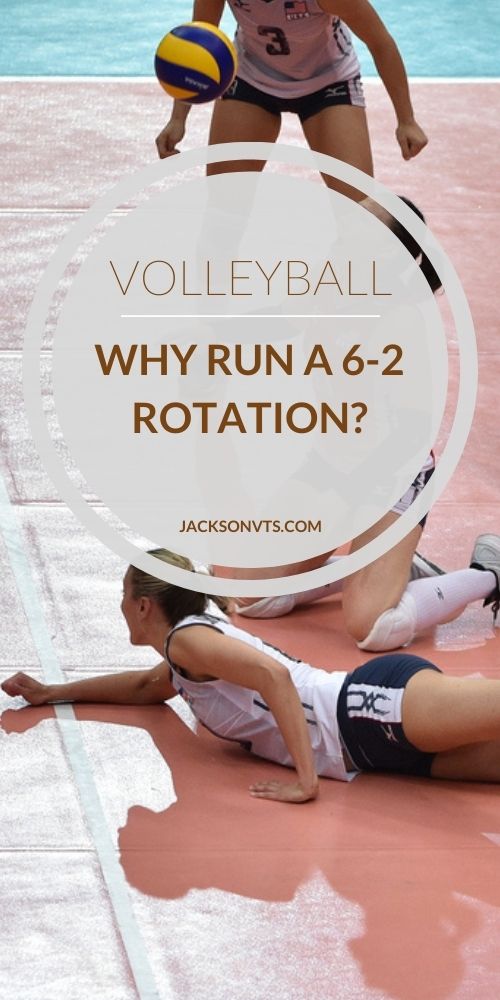6-2 volleyball rotation for the sport of 6 vs 6 player volleyball.
Offense for the 6-2 Volleyball Rotation
The most popular offensive system is the 6-2 offense. The reason it’s called a 6-2 is because you have 6 attackers and 2 setters.

The setters play opposite one another and set when they are on the back row.
Since the setters are only setting when they are on the back row, this means you’ll always have 3 attackers at the net at all times.
This is different than when running a 5-1 offense or a 4-2 offense.
In a 5-1, there is only one setter. This means the setter plays across the front row. When the setter is on the front row, there are only two attackers (so there are 5 attackers and 1 setter).
In a 4-2, there are two setters and they set when they are on the front row. This means there are only 2 attackers when the setter is on the front row (so 4 attackers and 2 setters total).

Setter in Left Back Rotation
In this diagram, the setter is in position 5 (left back). The setter is pushing up left front during serve receive. In position 5, the setter must remain closer to the left sideline than player in position 6, and the position 4 player must remain closer to the centerline.
Advantages to the 6-2 Volleyball Rotation
There are many advantages to running a 6-2 volleyball rotation…
- Always have 3 attackers at the net. Since the setter is always on the back row, you’ll always have 3 attacking options on the front row.
- Easier to make an adjustment to the line up. If you have two setters, it’s easier to make an adjustment if your team gets stuck in a certain rotation. For example, if your team is in trouble siding out, adjust your serve receive so your other setter can set in that particular rotation. Once you side out and are out of trouble, you can easily go back to your normal serve receive for running a 6-2 volleyball rotation.
- Setters don’t need to be skilled at playing the front row. If you are running a 5-1, you will need a setter that is skilled at blocking and possibly attacking. If you are running a 6-2, you don’t need your setters to have front row skills. This can be a big advantage because much shorter setters can just play across the back row and wouldn’t ever need to block or attack.
- Your setters only need to master the back row rotations. Since the setters are always on the back row when they are in the game, they only need to master the back row rotations. This can make it much easier for your setters because they can just focus on mastering these rotations and game situations.
- There’s less responsibility for your setters. Again, your setters only need to focus on learning the 3 rotations on the back row. Also, when a setter rotates to the front row and is subbed out of the game, the coach can then coach them from the bench. This coaching time can be invaluable because when the team has rotated around and is ready for the setter to come back in the game, the setter can implement what the coach has just taught.
- You can match up your setters and hitters. It’s usually best to figure out which attacker a setter is most comfortable setting. You can then match up the best setter/attacker combination.
Defensive Dive in Volleyball
Disadvantages to the 6-2 Volleyball Offense
There are a few disadvantages of running a 6-2 volleyball rotation…
- Your setters can’t attack. Since your setters are on the back row, they can’t ever attack at the net. This can be tough because if a passer passes the ball tight to the net, it can be difficult to save the ball. For example, if a setter reaches up above the net to save a ball and the setter accidently sends the ball over the net, this is an illegal play. The referee will whistle and call an “illegal back row attack”.
- It’s harder to get in position to set. It’s generally harder for a setter to get in position to set if the setter is always coming from the back row. For example, if a setter is running a 5-1 offense, when the setter is on the front row they are closer to the target area. So therefore, it’s easier to be in the right area to set the ball. In a 6-2, it’s generally harder to get near the target area because the setter needs to be careful of an overlap violation with the player that’s between the setter and net.
- More options for attacking. More options can actually be a disadvantage because a coach could get caught having a harder time deciding what play to run. Many teams have more success when there are fewer options because few options allows a team to just focus on a few things.
If you enjoyed these tips and would like to keep it close to you at any time, just save this pin to your Pinterest Volleyball Training Board.

Home › How to Play › 6-2 Rotation
